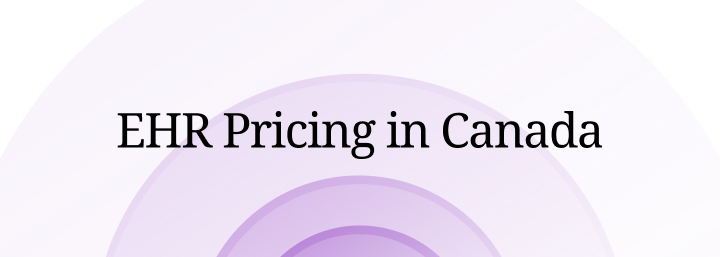How Much Does EHR Cost?
Table of Contents
Electronic health records (EHRs) are digital versions of patients’ medical histories, diagnoses, treatments, medications, allergies, and other health information. EHRs are essential for modern medical practices, as they enable better coordination of care, improved quality and safety of patient care, and increased efficiency and productivity of healthcare providers. However, implementing and maintaining EHRs can also be costly and complex, depending on various factors such as the size and type of the practice, the features and functionalities of the EHR system, the vendor and pricing model, and the additional costs and hidden fees involved.
In this blog post, we will explore the importance of EHRs for medical practices, the different pricing methodologies of EHR systems, the comparison of EHR pricing in different countries, and the hidden benefits of investing in quality EHR solutions. By the end of this post, you will better understand how much EHR costs and how to make the best decision for your practice.
The Importance of Electronic Health Records (EHRs) for Medical Practices
EHRs are more than just digital versions of paper records. They are powerful tools that can transform how healthcare is delivered and managed. Some of the benefits of EHRs for medical practices include:
Enhanced efficiency and time savings: EHRs can streamline workflows and processes, reduce administrative tasks, eliminate duplication and errors, facilitate communication and collaboration, and improve access to information.
Improved patient care and safety: EHRs can improve the quality and outcomes of patient care by providing accurate, complete, and up-to-date information, supporting clinical decision-making, enabling preventive care and chronic disease management, reducing medication errors and adverse events, and facilitating patient engagement and education.
Streamlined documentation and interoperability: EHRs can simplify and standardize the documentation of patient encounters, diagnoses, treatments, prescriptions, referrals, billing, coding, and reporting. EHRs can also enable interoperability among different healthcare providers, systems, organizations, and settings, allowing seamless exchange and sharing of health information.
Understanding EHR Pricing Methodologies
One of the most challenging aspects of choosing an EHR system is understanding how much it costs. There is no one-size-fits-all answer to this question, as different vendors have different pricing models and methodologies. However, some common elements can help you compare and evaluate different options. These include:
Upfront Licensing or Subscription Costs
The initial fee to acquire or access the EHR system is the upfront cost. This cost can vary depending on whether you choose a one-time purchase or a recurring subscription model.
One-time purchase: You pay a lump sum to buy the software license or hardware device that allows you to use the EHR system indefinitely. This option usually has a higher upfront cost but lower ongoing costs. However, it may also require additional costs for maintenance, upgrades, support, training, etc.
Recurring subscription: You pay a monthly or annual fee to access the cloud-based or web-based EHR system via the Internet. This option usually has a lower upfront cost but higher ongoing costs. It may also include maintenance, upgrades support, training, etc., as part of the subscription fee.
The upfront cost can also depend on other factors, such as:
The number of users or providers who will use the system
The number of patients or records that will be stored in the system
The features and functionalities that are included or excluded in the system
The customization or integration options that are available or required for the system
| Model | Advantages | Disadvantages |
|---|---|---|
One-time purchase | - Higher upfront cost but lower ongoing costs
- More ownership and control over the system
- Less dependency on internet connection or vendor service | - Additional costs for maintenance, upgrades, support, training, etc.
- Higher risk of obsolescence or incompatibility
- More responsibility for data backup and security |
Recurring subscription | - Lower upfront cost but higher ongoing costs - More flexibility and scalability of the system - More maintenance, upgrades, support, training, etc., included in the subscription fee | - Less ownership and control over the system - More dependency on internet connection or vendor service - Less responsibility for data backup and security |
Additional Costs and Hidden Fees
The upfront cost is one of many costs you must consider when choosing an EHR system. Other costs or fees may not be included in the initial quote or contract but may arise later on during or after the implementation process. These include:
Implementation costs: These are the costs associated with installing, configuring, testing, launching, and migrating data from existing systems to new systems.
Maintenance costs: These are the costs associated with keeping the system running smoothly, updating software, fixing bugs, resolving issues, etc.
Upgrade costs: These are the costs associated with adding new features, functionalities, or modules to the system or switching to a newer version.
Support costs: These are the costs associated with providing technical assistance, troubleshooting, etc., to the system users.
Training costs: These are associated with educating and training the staff on using the system effectively and efficiently, both when they first start using it and as new features or functions are added.
Integration costs: These are the costs associated with connecting the system with other systems, devices, or applications used by the practice, such as billing, scheduling, lab, pharmacy, etc.
Customization costs: These are the costs associated with modifying or adapting the system to meet the specific needs or preferences of the practice, such as adding custom fields, templates, reports, etc.
Data backup and security costs: These are the costs associated with protecting the data stored in the system from loss, theft, damage, or unauthorized access, such as encrypting, backing up, restoring, etc.
Factors Affecting EHR Pricing
As you can see, many factors can influence the cost of an EHR system. Some of these factors are related to the vendor or the system itself, while others are related to the practice or the user. Here are some of the most common factors that can affect EHR pricing:
Vendor reputation and experience: The more established and reputable the vendor is, the more likely they are to charge higher prices for their products and services. However, they may offer higher quality, reliability, and customer support.
System features and functionalities: The more features and functionalities the system has, the more likely it is to cost more. However, not all features and functionalities may be necessary or useful for your practice. You should evaluate your needs and priorities and choose a system that meets them without paying for unnecessary extras.
System usability and performance: The more user-friendly and efficient the system is, the more likely it will save you time and money in the long run. It would help if you looked for a system with a simple and intuitive interface, a fast and responsive performance, and a low learning curve for your staff.
System scalability and flexibility: The more scalable and flexible the system is, the more likely it is to grow and adapt to your practice. It would help if you looked for a system that can accommodate changes in your practice size, volume, specialty, location, etc., without compromising quality or functionality.
Practice size and specialty: The size and specialty of your practice can affect your EHR pricing in several ways. For example:
Larger practices may need more users, records, features, functionalities, integrations, customizations, etc., which can increase the cost of the system.
Smaller practices may have fewer resources, budgets, staff, etc., which can limit their options for choosing an EHR system.
Specialty practices may have specific requirements, regulations, workflows, etc., affecting their EHR pricing.
Comparing EHR Pricing in Different Countries
EHR pricing can vary significantly across different countries due to market size, competition, regulation, standards, culture, etc. Here are some examples of how EHR pricing differs in three major countries:
EHR Pricing in the United States

The United States has one of the world's largest and most diverse markets for EHR systems. There are hundreds of vendors offering different types of EHR systems for different types of practices. A Federal Agency for Healthcare Research and Quality study found that the average purchase and implementation cost of an EHR system in the United States is $32,606 per FTE physician, and maintenance costs are another $1,500 per physician per month.
The United States also has some unique factors that affect EHR pricing, such as:
Government incentives and penalties: The federal government has implemented various programs to encourage and reward healthcare providers' adoption and use of EHR systems. For example:
The Health Information Technology for Economic and Clinical Health (HITECH) Act provides financial incentives for eligible providers who demonstrate meaningful use of certified EHR technology.
The Medicare Access and CHIP Reauthorization Act (MACRA) establishes a new payment system that rewards providers who participate in advanced alternative payment models (APMs) or report quality measures under the merit-based incentive payment system (MIPS).
However, these programs also impose penalties for providers who fail to meet the requirements or standards of these programs. For example:
Providers who do not demonstrate meaningful use of EHRs by 2023 will face a 5% reduction in their Medicare payments.
Providers not participating in APMs or MIPS will face a 9% reduction in their Medicare payments by 2023.
Vendor certification and accreditation: The federal government has established criteria and standards for EHR systems to ensure their functionality, interoperability, security, and quality. For example:
The Office of the National Coordinator for Health Information Technology (ONC) certifies EHR systems that meet the requirements of the HITECH Act and the MACRA.
The Electronic Healthcare Network Accreditation Commission (EHNAC) accredits EHR vendors that meet the standards of privacy, security, and data exchange.
These programs and standards can affect EHR pricing by increasing the costs of development, testing, compliance, and maintenance for vendors, which may be passed on to customers.
EHR Pricing in Canada

Canada has a nationalized healthcare system funded and regulated by the federal and provincial governments. However, Canada has yet to implement a national EHR system or strategy. Instead, each province or territory has its own EHR system or initiative, which may vary in scope, features, functionalities, standards, and funding.
Canada also has some unique factors that affect EHR pricing, such as:
Government funding and incentives: The federal and provincial governments provide funding and incentives for developing, implementing, and adopting EHR systems by healthcare providers. For example:
Canada Health Infoway is a federally funded organization that invests in digital health projects across Canada, including EHR systems.
The Physician Information Technology Office (PITO) is a provincially funded program that provides financial and technical support for physicians in British Columbia who use certified EHR systems.
However, these programs may also impose conditions or limitations on the eligibility or availability of funding or incentives for providers or vendors.
Vendor competition and regulation: The Canadian market for EHR systems is relatively small and fragmented compared to the United States. Fewer vendors are offering fewer options for different types of practices. Vendors may also face more regulation and oversight from the federal and provincial governments, as well as from professional associations and accreditation bodies. For example:
The Canadian Medical Protective Association (CMPA) provides legal advice and assistance to physicians who use EHR systems, as well as guidelines and recommendations for best practices.
The Canadian Standards Association (CSA) develops and maintains standards for health informatics, including EHR systems.
These factors can affect EHR pricing by influencing the supply and demand of EHR systems in Canada and the quality and reliability of the products and services offered by vendors.
EHR Pricing in the United Kingdom

The United Kingdom has a publicly funded healthcare system managed by the National Health Service (NHS). The NHS has a national strategy and vision for digital health transformation, including healthcare providers' adoption and use of EHR systems. The ONC claims that overall costs for electronic health records can vary from $15,000 to $70,000, which is quite a broad range. A more exact number depends on the platform type, the healthcare provider’s existing IT resources, additional personnel training, and other factors.
The United Kingdom also has some unique factors that affect EHR pricing, such as:
Government procurement and contracts: The NHS procures and contracts EHR systems from vendors on behalf of healthcare providers through various frameworks and agreements. For example:
The GP Systems of Choice (GPSoC) framework allows general practitioners (GPs) to choose from a list of approved EHR systems funded by the NHS.
The Health Systems Support Framework (HSSF) allows NHS organizations to access a range of digital health solutions, including EHR systems, from a list of accredited suppliers.
However, these frameworks and agreements may also impose restrictions or requirements on providers' or vendors' selection or implementation of EHR systems.
Vendor innovation and collaboration: The United Kingdom market for EHR systems is relatively mature and competitive compared to other countries. Many vendors offer different types of EHR systems for different practices. Vendors may also face more pressure and opportunities to innovate and collaborate with the NHS and other stakeholders and partners in the digital health ecosystem. For example:
The NHS Digital Academy is a national program that provides education and training for digital health leaders, including EHR vendors.
The NHSX is a joint unit that brings together the NHS, the Department of Health and Social Care, and other partners to drive digital transformation, including EHR systems.
These factors can affect EHR pricing by stimulating the development and improvement of EHR systems in the United Kingdom and the integration and interoperability of the products and services offered by vendors.
Conclusion
EHR systems are essential for modern medical practices, as they can provide many benefits, such as enhanced efficiency, improved patient care, and streamlined documentation. However, EHR systems can also be costly and complex, depending on various factors such as the vendor, the system, the practice, and the country. Therefore, it is important to understand how much EHR costs and how to make the best decision for your practice.
FAQ
The cost of an EHR system varies depending on several factors. These factors include the size and type of your medical practice, the features and functionalities you need, the vendor you choose, and the pricing model (one-time purchase or recurring subscription). Additional costs like implementation, maintenance, upgrades, support, training, integration, and customization can also impact the overall cost. It's important to carefully evaluate your practice's requirements and budget to make an informed decision.
EHRs offer numerous advantages for medical practices. Some benefits include enhanced efficiency through streamlined workflows and reduced administrative tasks, improved patient care and safety by providing accurate and up-to-date information, better communication and collaboration among healthcare providers, and simplified documentation and interoperability. EHRs can also facilitate preventive care, chronic disease management, and patient engagement while supporting clinical decision-making and reducing medication errors. Understanding these benefits can help you realize the value of investing in an EHR system.
EHR pricing can differ significantly between countries due to factors like market size, competition, government incentives, and regulations. For instance, in the United States, the cost can range from an average of $32,606 per FTE physician for purchase and implementation, with maintenance costs of $1,500 per physician per month. In Canada, funding and incentives from federal and provincial governments impact EHR pricing. In the United Kingdom, government procurement frameworks and vendor collaboration influence pricing. Understanding the unique factors in each country can help you assess the potential cost of implementing an EHR system.
Documentation and Administrative Tasks?